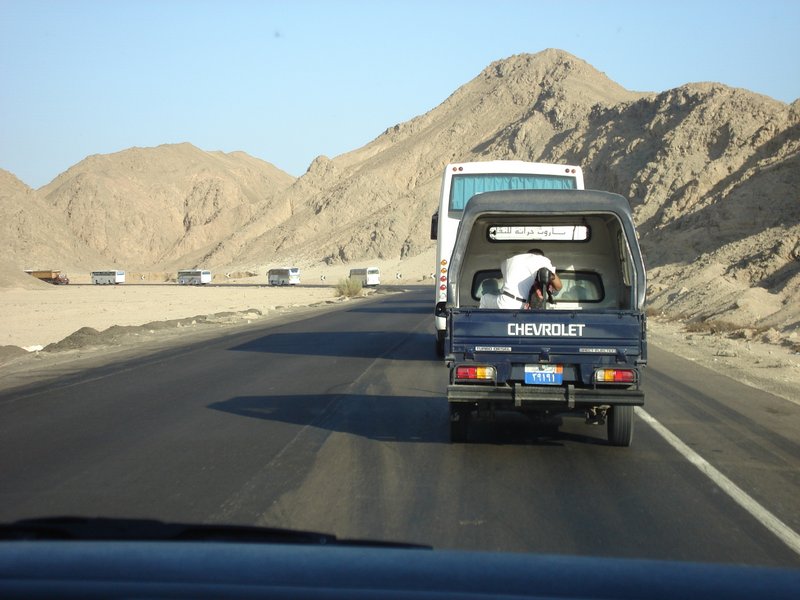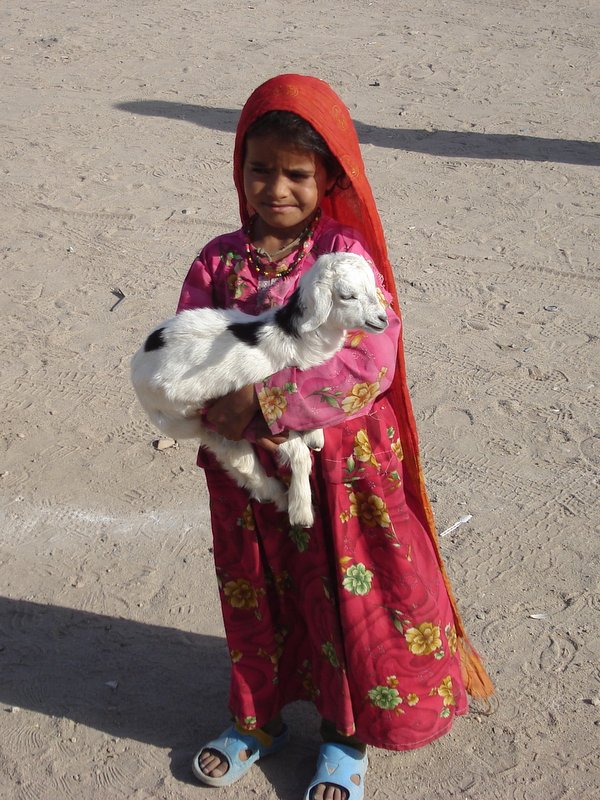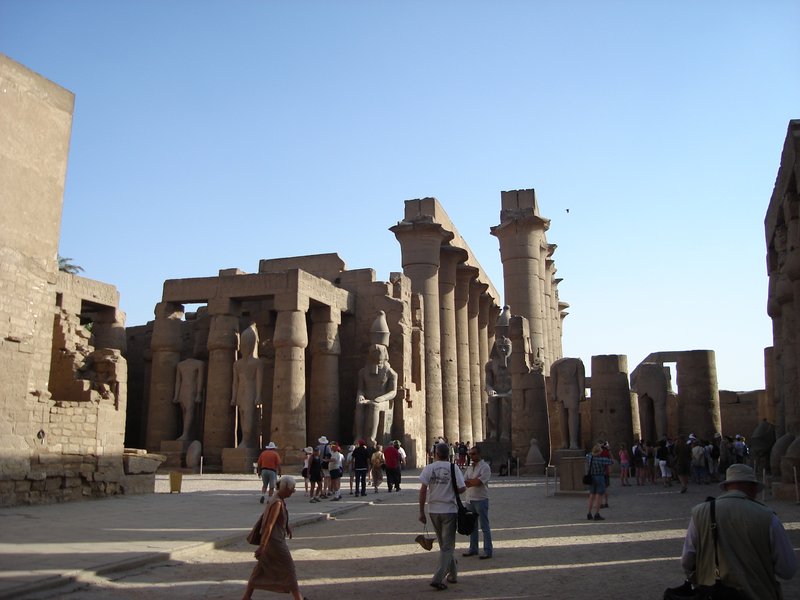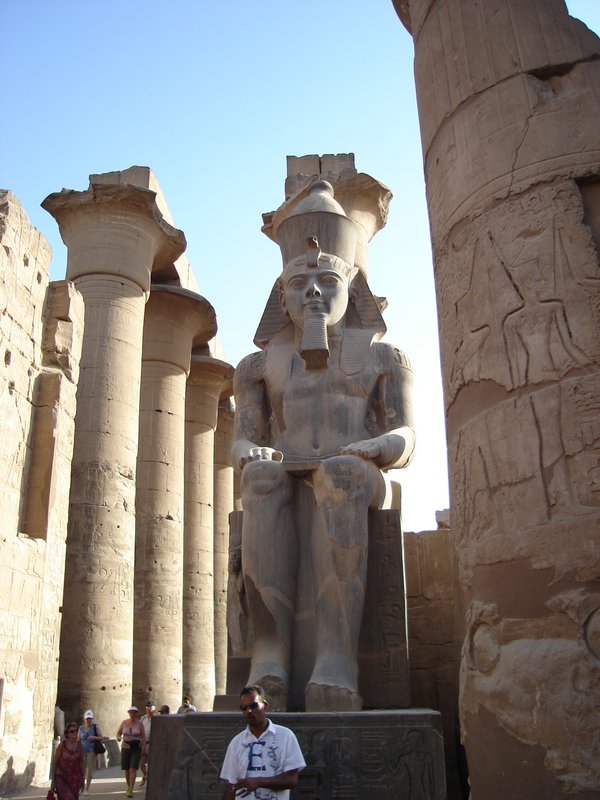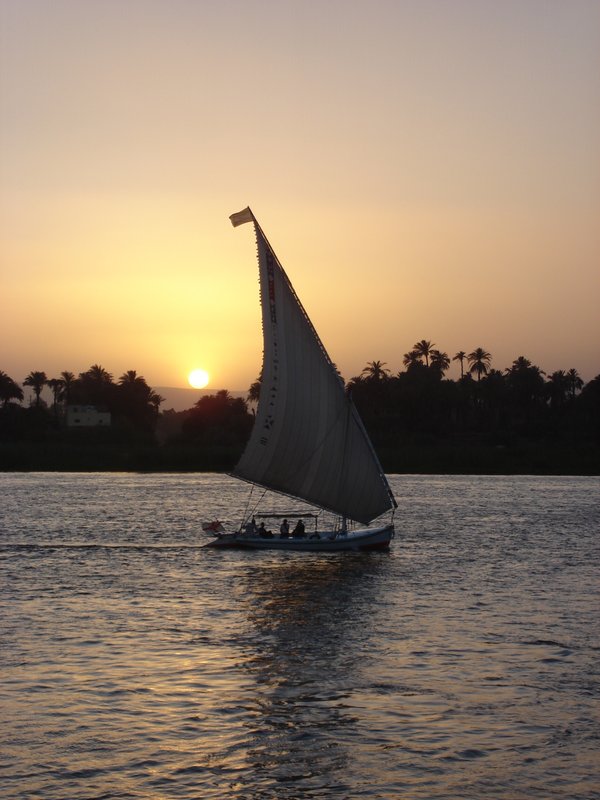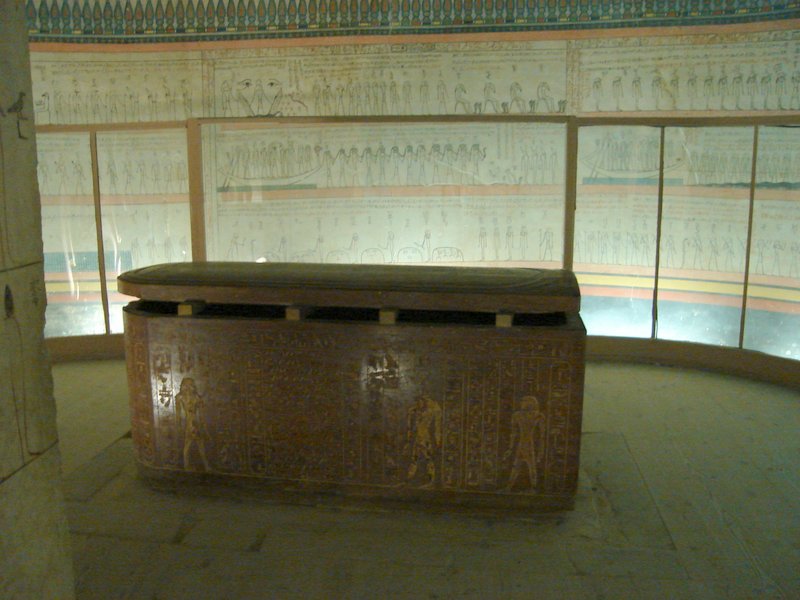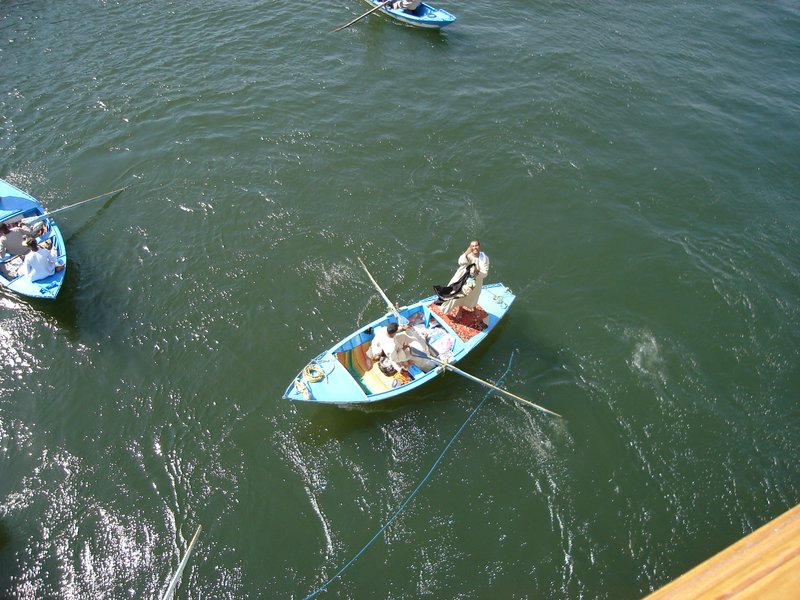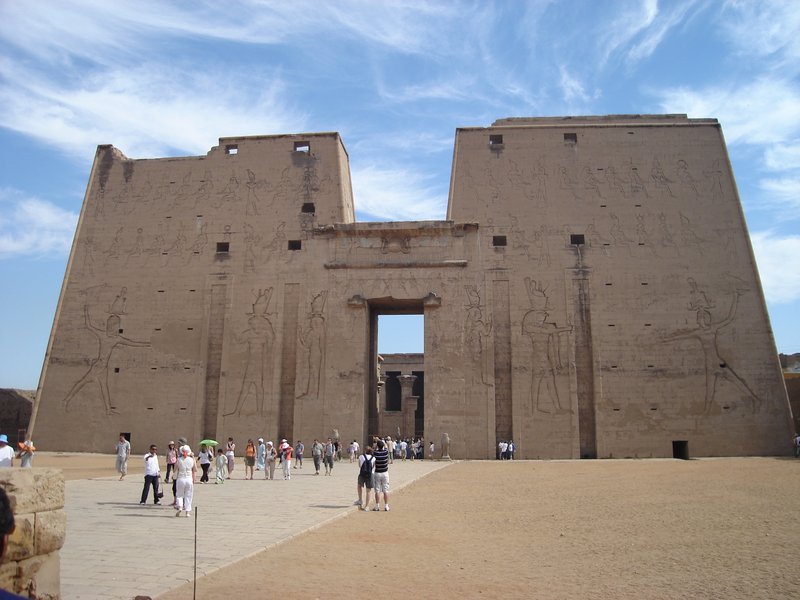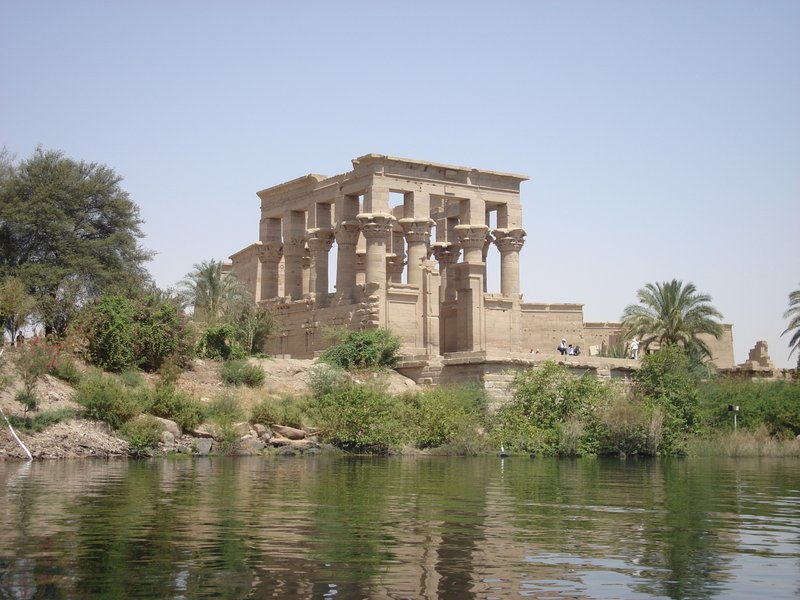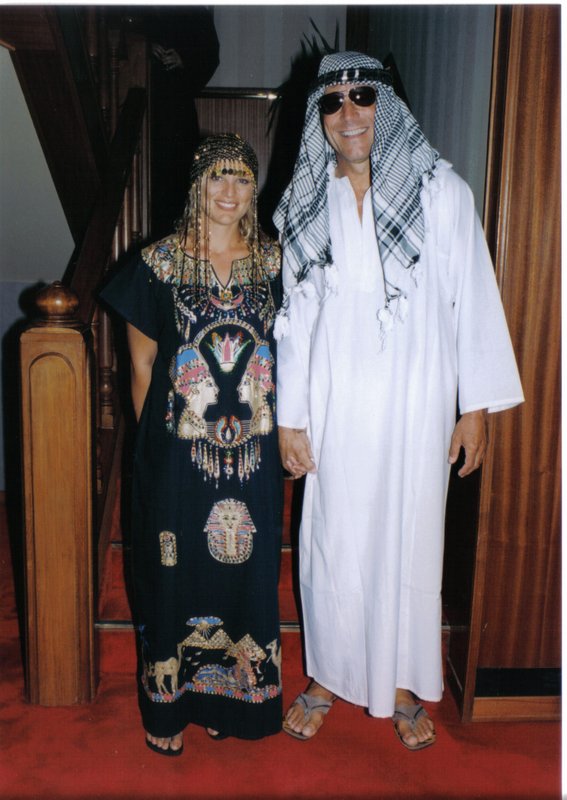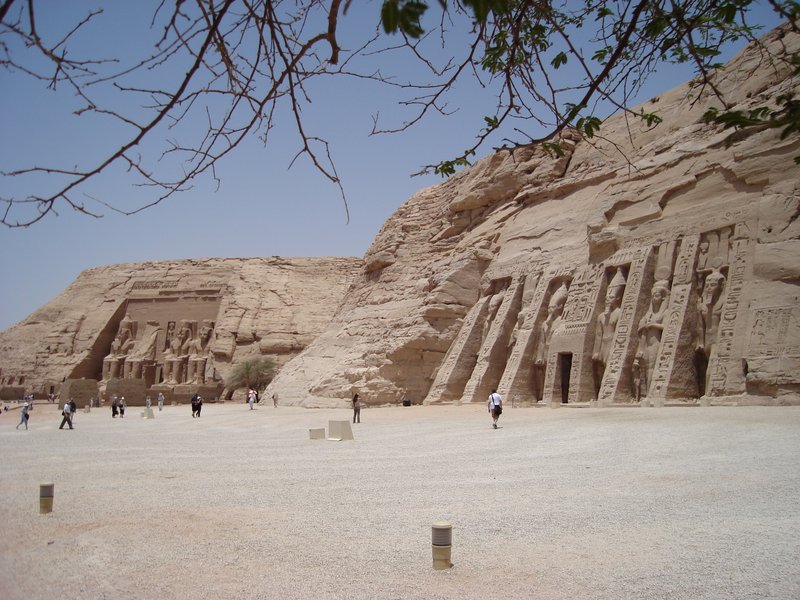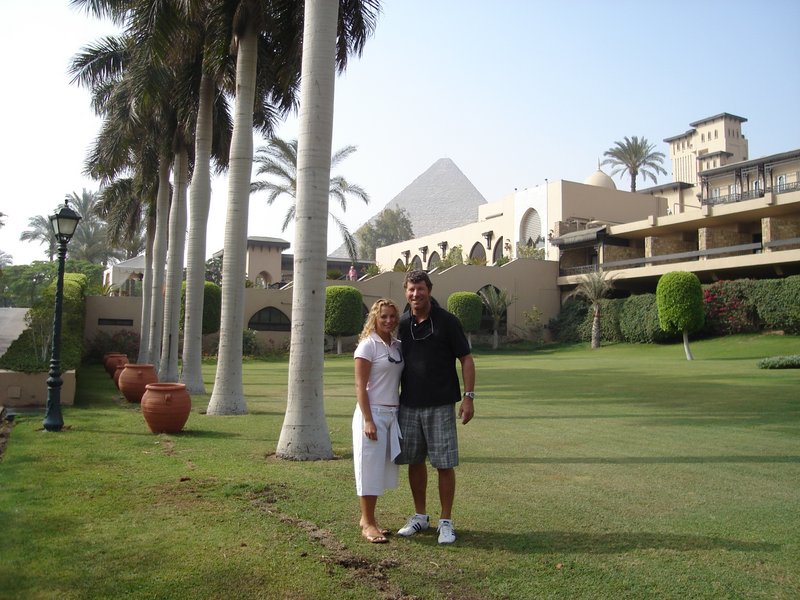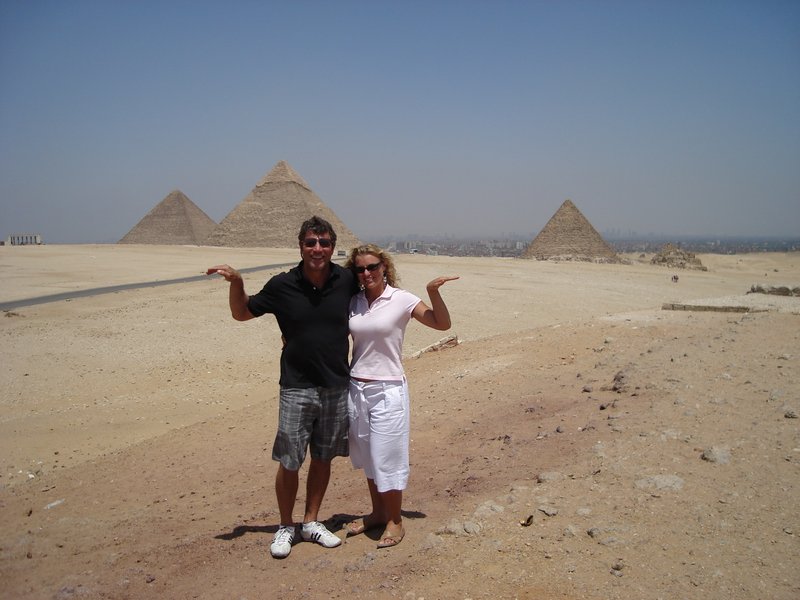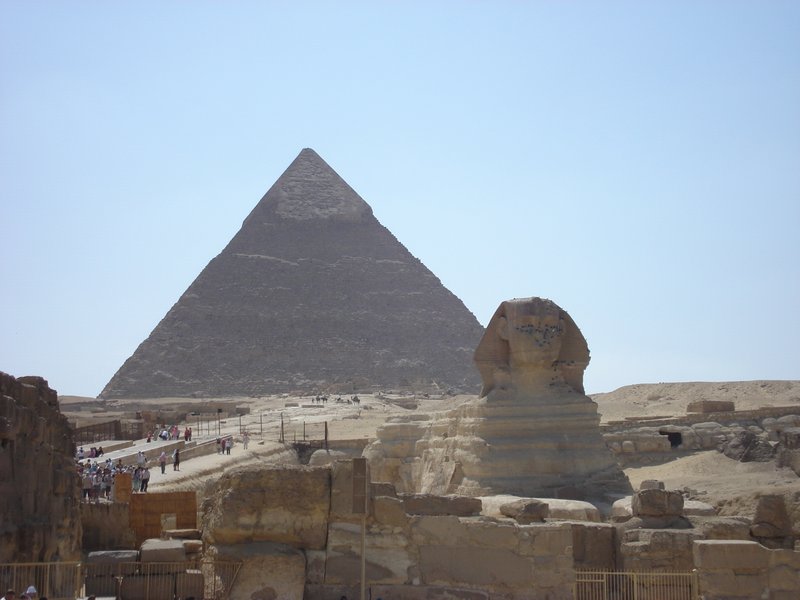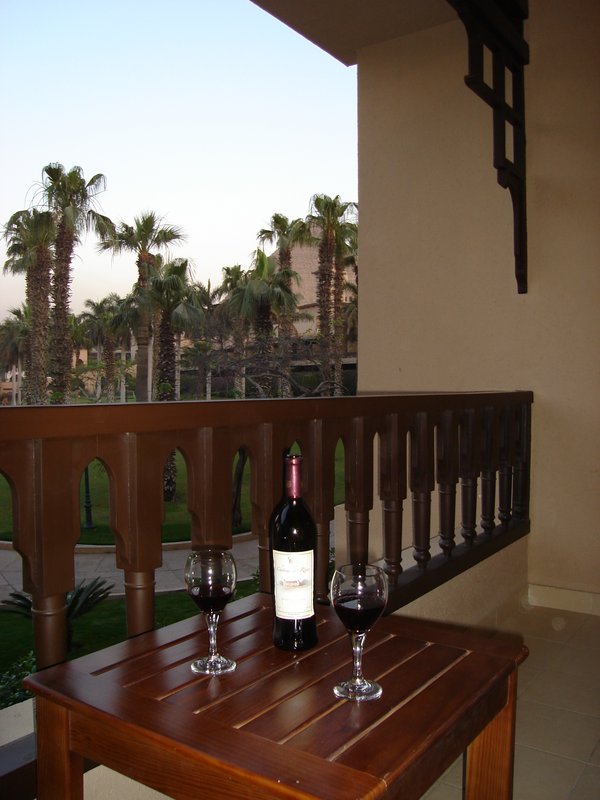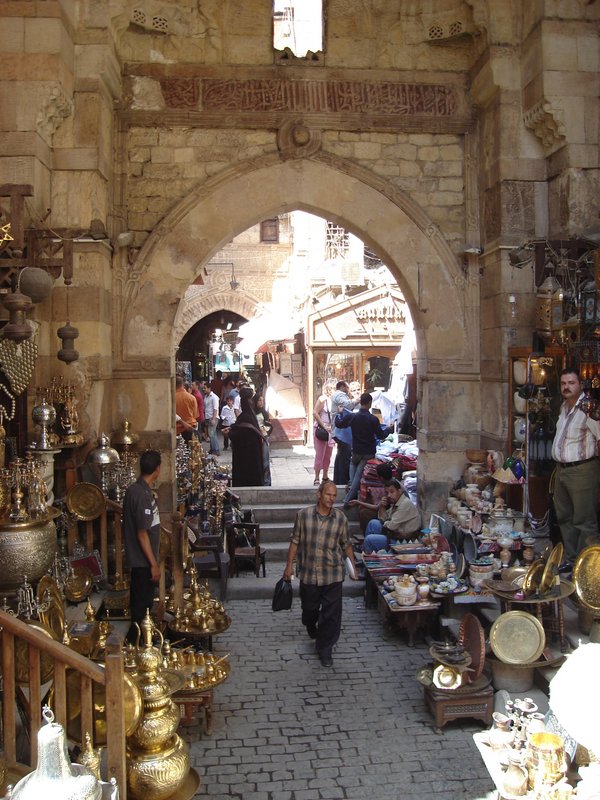28 April
We had enough light at 0700 to see our way out of the pass into Elba Reef, and we spent the day motor sailing northward, finishing at Shab Abu Fendera (Fendera Reef), just across the border into Egypt, at about 1530 hours just after being converged upon by a very large pod of mischievous dolphins. One of them even splashed me when I was up on the bow watching. Fendera Reef is also very inadequately charted but we had good enough light to get in and anchor in 25 meters of water in the lee of the large coral patch. Winds for the day were light and variable, never exceeding 6 knots, and the sea state was slight, making for a fast and relaxed trip.
29 April
At first light we lifted the anchor and followed our track back out of Fendera Reef. Winds were light from the northeast, so we made an 85 mile dash to Dolphin Reef where we planned to relax for a couple of days and do some diving. We made it in just shy of ten hours and had good light for the approach to the reef anchorage. There were four liveaboard dive boats moored on the reef, so we reckoned the diving must have been pretty good. There were also five other cruising yachts at anchor, so we had a bit of company.
30 April
I woke up early in the morning to howling northerly winds, feeling sorry for the boats that were on overnight passage heading north. Although we would be sitting out the blow in the comfort of Dolphin Reef we would be accumulating a fresh coat of red dust. Winds were in the 20’s gusting to 30 in the morning but moderated to around 15 late in the morning. We splashed the dink and headed to the east side of the reef and had a nice dive on a beautiful wall there. The sea life consisted mostly of smaller reef fish, but we did spot a couple of nice sized maori wrasse, a white tipped reef shark cruising along the wall, and a very inquisitive sea turtle. The Red Sea has not disappointed us in its diving. We had all the other yachties around for happy hour(s) on Moonshadow that evening.
1 May
We were weather bound again by a fresh northwester from 15 to 25 knots. The seas crashing on the windward side of the reef were off-putting enough to keep us here for another day or so. Merima passed the time baking and sewing, and I caught up on some writing and photo organizing. It was too windy to do any work outside and if we touched anything exposed, we would get red dust all over ourselves.
2 May
Weather-bound for a third day! The bar has hit a peak and started dropping, so it looked like the end of the blow was on the radar screen. We had a good long dive on the east wall. It was probably the best dive we’d had in the Red Sea to date. We saw a small school of big dog tooth tuna schooling by, schools of trevally, some huge red snapper in the pukas, lots of lion fish, a couple of large maori wrasse and a huge moray eel. The wall is just covered with hard and soft coral, sponges, fans, gorgonians and other colorful encrustation.
3 May
After a calm night, it was time to move north again. We got underway as soon as we had enough light to get a visual on the tricky reef at the pass, around 0730. We made it out OK and bashed through a residual swell of about a meter, and light easterlies. After an hour or two, the seas moderated and we had a good fast ride north to Gezirat Wadi Gimal about 48 miles from Dolphin Reef. Because the winds were forecast to be out of the south, we decided to press further north a few miles to Shab Ghadeira, where we would have better protection and an easy exit before good light the next morning for the longer (58 nm) leg to Port Ghalib. We wanted to be in a good position to arrive in Port Ghalib with good light and early enough to get checked in, as there were about 8-10 boats arriving Friday after a weather-bound backlog.
We anchored in 17 meters and the wind absolutely died. The whole scene was surrealistic, with clouds reflecting off the sea, and the sea and sky blending into infinity in a light mist. The evening’s entertainment was listening to all the goings on on the VHF radio. There’s usually a lot of chatter between ships’ crew in the Red Sea, mostly ethnic slurs that drive us to the point of switching off the radio. But this evening there was a very articulate man with an Arabic accent who had quite a good shtick. He could have been Ali G for his wild sense of humor. He was taking the piss out of the Coalition Warships and various ethnicities. We also heard one of the yachties going stealth as they thought they were being stalked by a couple fishing boats. It seems that some people don’t have enough drama in there lives, so they create it in their imagination.
4 May
We were definitely getting close to civilization. We started seeing more buildings ashore, and a mega resort every couple of miles up the coast. Navigating through the myriad of reefs was easy as they were almost all well marked by dive boats, spilling divers on to over-dived sites. The number of floating plastic bottles we saw was disgusting, and reminded us of the endless sea of rubbish we encountered in Indonesia. And they call this “eco-tourism?” We arrived at Port Ghalib at about 1400 hours. There were 13 other yachts at the Customs dock. Customs were waiting for our arrival before taking all the paperwork to the airport for processing. Some of these frustrated yachties had been waiting since 0600 that morning!
A couple of hours later, with the Egyptian check-in formalities completed, we got tied up and plugged into shore power for the first time in nearly four months. Water, well that was another story. There was only one outlet, about 100 meters away, so we’d have to form a hose brigade. At least we could get a nice meal out and drinks at the dive resort attached to the marina. Otherwise, Port Ghalib was still pretty much of a construction site and quite lacking in facilities. Its most redeeming quality is that it had the first, last and only proper fuel dock (that we were aware of) with a pump in the Red Sea. After our last fueling experience in Suakin, this was a big draw card for us. We decided that we would get fuel, get provisions, and get out! It was nice to have a good meal out again.
5 May
I spent the first hour and a half of the morning forming the “hose brigade.” That is gathering all the hoses from the side tied boats and trying to mate the myriad of different connections so that we could get water from the hotel outlet to the last boat, some 300 feet away. Once this was accomplished we all began taking turns washing off many weeks accumulation of dust, salt and “pink stuff” which is a gooey combination of the two. When we finally got the hose that afternoon, we rediscovered that the boat was in fact white and got her really clean again for the first time in months. We enjoyed a great meal at the resort’s buffet that night and relaxed afterwards in the sheesha garden with a big pipe.
6 May
It was a mostly relaxing day as we made preparations to depart the following day. The marina office assured us paperwork would be ready by that afternoon “100%”-sure! Merima ordered some fresh provisions through the resort which were very nice, and delivered right to the boat that afternoon. The paperwork didn’t show up but the duty officer in the harbor office said he’d fax it ahead to Abu Tig Marina, our next stop. My confidence level with the Egyptians so far was hovering close to zero.
7 May
We were up at 0500 and headed over to the fuel dock. Filling was fast, clean and easy, but after first getting a pre-approval for our purchase, their Visa card machine wouldn’t work any more. Further, they would not accept Egyptian pounds, only US dollars. I wanted to make a bit of a stink and wait till the credit card machine would work so we didn’t have to use the cash that was earmarked for the Suez Canal transit fees, but we had a long day plan and needed to get moving. We got away by 0730 and made it to the next good anchorage, nearly 80 miles north, by sunset.
8 May
We were up early and made our way further up the Sea in light northerlies. We passed the resort area of Hurghada where there was literally one mega resort next to another for miles along the shoreline. Even more were under construction. It looked as if there were enough rooms available to accommodate half of Europe, Asia and Russia all at the same time. From what we could see from seaward, most of the beaches looked very average and were overcrowded with oversized people wearing undersized bathing suits.
We made the last 58 miles to Abu Tig Marina by early afternoon and were happy to arrive in a “real marina, “i.e. not a construction zone, with all, if not most of the facilities and amenities fully operational. The marina staff at Abu Tig was most welcoming and very helpful in getting us into a very tight med-moor slot. After we got tied up, plugged in and the pasarelle installed, we went straight to the travel agency to book our Egyptian land travel. We organized an eight day inland tour with a very nice and helpful travel agent named Tamer Ramzi who managed the Pro Tour office in the marina. The itinerary covered almost everything we wanted to see in Egypt within a realistic time frame and the price was very reasonable.
It was nice to be able to relax and enjoy some of the amenities offered by a first world style marina-shopping, cafes, bars, restaurants, live music, grocery stores, WiFi, etc.
9 May
We spent most of the day tidying up Moonshadow, rinsing down, vacuuming up and wiping off yet another buildup of red dust that had been bestowed upon us, courtesy of the Arabian Desert and the unrelenting northerly winds. At least at the end of a hard day’s work, we enjoyed a stroll around the marina, checking out the mega yachts of Egypt’s rich and famous and enjoyed a nice meal out and a sheesha and music afterwards.
12 May
We were picked up by a mini bus at 0530 and headed for Luxor along with our cruising friends Susan and Ron from Gemini who would be our traveling companions for the next week. We were on vacation!!! We headed to the town of Safaga where we joined a police escorted convoy of tourist buses headed for Luxor. The convoy is meant to protect tourists from an attack by insurgents who would like to destroy Egypt’s huge tourism industry. In theory it seems intelligent, but practically speaking, all it does is put all the tourists together at a set time and place so that we could be one easy target. There have been no attacks on tourists for years, but the whole convoy thing, including rest stops, has become a big and very cheesy business for the Egyptians along the convoy routes. We soon found that what lines the pockets of Egyptians in most cases is more important than the convenience, safety, pleasure and comfort of the tourists.
The tourist convoy to Luxor.
A girl and her pet goat poses for photos at a rest stop.
We arrived in the ancient city of Luxor late in the morning and boarded the Nile Admiral, which would be our home base for the next four days. I suppose it is a bit ironic for cruisers going on “vacation” to go on a cruise. The Nile Admiral had been recently refit and was up to five star standard with beautiful accommodations, excellent food and friendly and helpful staff. We wouldn’t be losing any weight on this trip!
After an excellent buffet lunch we spent the afternoon with our guide, a lovely Egyptian lady called Raga, touring the magnificent temples of Karnak and Luxor. Merima and I soon discovered that we could spend hours just studying the intricate and interesting hieroglyphics and artwork carved in relief and painted on the temple walls.
Luxor Temple.
Dinner aboard the ship, accompanied by a surprisingly good Egyptian wine was excellent!
A felucca on a sunset sail on the Nile.
13 May
We spent the entire morning on the West Bank of the Nile at Luxor, visiting the Necropolis of Thebes, the Two Colossi of Memnon, the Valley of the Kings and the temple of Queen Hatshepsut in the Valley of the Queens. Of course no visit to the Valley of the Kings is complete without a foray into the tomb of Tut Ankh Amun, known to most simply as “King Tut.” Even though the boy king was one of the lesser pharaohs, he has become so popular because his was the only tomb in the Valley of the Kings to be discovered intact, with all its riches having escaped tomb raiders for thousands of years. The actual tomb is quite small, and after visiting the exhibit of the riches discovered inside, one wonders how it all fit.
We thoroughly enjoyed the tombs and were fascinated by what stories might be told by the myriad of hieroglyphics and carved reliefs covering the walls inside the ancient tomb, many of which are fully intact and/or still showing bright color.
King Tut’s tomb.
Ancient emoji.
We were back on board the Nile Admiral in time for a late lunch and sailed for Esna, where the ship stopped and waited to negotiate a lock before continuing up the Nile to Edfu where we tied up for the night. Sitting on the top deck watching the stunning scenery of the fertile Nile River Valley going by was a wonderful and relaxing way to spend the day while we left the driving to someone else. As we approached the waiting area, we were chased by a dozen or so men in rowboats, some who managed to get lines tied to part of the ship. They were selling various clothing items like T-shirts and galabayas, the full length shirt/dress worn by local men and women. They had a very interesting marketing scheme. They would come along side the boat, and throw their items up to people on the top deck of the ship (three stories up) or looking out of their stateroom windows. If someone wanted to make a purchase, they would put the money in the plastic bag and toss it back to the guy in the boat. Otherwise, unwanted items were tossed back down, sometimes missing the boat. We dubbed this sales technique, the “row and throw.”
The rowboat merchants.
That evening after dinner, we enjoyed looking out at Edfu, still appearing to be in colonial times, with its beautiful old architecture and ornate horse-drawn carriages parading along the riverfront.
14 May
After an early breakfast we were off to visit the temple of Horus in Edfu, after which we returned to the ship and sailed for Kom Ombo. After lunch and a relaxing afternoon cruise, we stopped to visit the temple shared by the two Gods Sobek and Haroeris. While we found that we often got “templed out” in Asia, the Egyptian temples are all unique and had many interesting features to capture our interest. Of particular interest in the temple at Kom Ombo was a carved relief depicting some surgical instruments, extremely advanced for the era, as well as a room containing two mummified crocodiles on display. After our temple visit, we sailed on to Aswan, the end of the line for the cruise ship.
15 May
Peering out of the window in the morning, the scenery was stunning. In the distance we could see ancient tombs carved into the hillside above the river, and the ruin of a monastery which had been built into the cliffs above. In the foreground there were small green islands in the middle of the Nile, with feluccas, the local sailing boats, moored on them as well as on the river banks. In the morning we visited the Aswan High Dam. While it may be an engineering marvel, it is certainly not much to look at. After, we visited the temple of Philae, perched in a placid setting on a small island above the dam in Lake Nasser. It is one of many temples that had to be taken apart and reconstructed on higher ground to avoid being covered forever by water.
The Temple of Philae.
After lunch we enjoyed a boat ride around Aswan’s Elephantine Island, affording us good views of the Mausoleum of Agha Khan and the Old Cataract Hotel, made famous by Agatha Christie in her book Death on the Nile. We would have preferred a ride on a felucca, but apparently there was too much wind. Not for us!
Elephantine Island.
That evening was fancy dress night on the ship. Most of the guests dressed in galabayas, the traditional Egyptian dress worn by men and women that resembles a long nightgown. They are actually quite comfortable, but not roomy enough for dancing without hiking them up a bit. The crew organized some Club Med type games for the party after dinner and it was quite a fun event.
Fancy Dress Night on the Nile Cruise.
16 May
After breakfast we headed to the airport and boarded an Egypt Air flight to Abu Simbel, a half hour flight that put us near the border of Egypt and Sudan on Lake Nasser. Abu Simbel is the site of two temples built by King Ramses II for himself and his favorite wife.
The Egyptians call Ramses II the “Busy Man” as he never did anything in halves. He had dozens of wives and 150-200 children (and they named a brand of condoms after him?), depending on who you talk to. He was a war hero and the first to attempt to create a navigation link between the Red Sea and the Med Sea. I guess his temples couldn’t be garden variety either.
The first extraordinary thing about these two temples is that they were not built in the typical manner of piling stone blocks one on top of the other, but in fact were totally carved into the side of a solid sandstone cliff. Mind you, this was done around 1200 B.C., so it was a bit before they had jackhammers, power drills or dynamite, so one can only guess how many gazillion man-hours of hammer and chisel went into this temple. The painting and reliefs in the temples are mostly intact and they are truly an awesome sight to view. The second extraordinary thing about this site is that in order to prevent the temples from being covered forever by the rising waters as Lake Nasser filled up behind the Aswan high dam, they were painstakingly cut into pieces, in some cases with hand saws, and then meticulously reconstructed on higher ground just above the original site so that the suns rays would penetrate deep into the far reaches of the temples as they did in their original positions The Egyptians literally moved mountains to preserve this amazing piece of history.
Abu Simbel.
We hopped a flight back to Aswan, enjoyed a very tasty local style lunch in town and then boarded an overnight train to Cairo. Our sleeper car was small but reasonably comfortable, the dinner barely edible but greatly improved by a bottle of Jardin du Nile Egyptian wine. We were told that there was beli dancing in the Club Car that evening. When we showed up, we found what looked like a scene out of a 60’s movie, quite smoky from a group of Japanese tourists partying at one end. The beli dancing consisted of one of the waiters dancing with a pair of oranges stuffed into his shirt, who then recruited Susan and Merima to join him. We all had a few laughs and enjoyed a couple drinks before retiring to our cabin.
The overnight train was an interesting experience and we managed to get some rest. If it wasn’t so quiet, at least it wasn’t heeling much, and we didn’t have to take turns standing watch all night.
17 May
We arrived at Geza Station on the outskirts of Cairo at about 0630 after what was meant to be a “continental breakfast.” We hustled off the train and were transferred to the Hotel Mena House. Along the way, quite by surprise, we caught a glimpse of the Great Pyramids out the window.
Set in the shadows of the Great Pyramids, Mena House was once a hunting lodge for the King of Egypt. The hotel remains spectacular in its architecture, décor, beautiful grounds and world-class service. This would have to rate as one of the world’s great hotels, and is truly the nicest place we’ve ever had the pleasure to stay in.
We spent the day visiting Memphis, the pyramids of Sakkara (a.k.a. the Step Pyramids) the Temple of the Valley, the Great Pyramids of Geza and the Sphinx. While we could have given Memphis and the Step Pyramids a miss, no matter how many times one sees these things in photos, there is absolutely nothing so moving as encountering the Great Pyramids and the Sphinx in person.
At the Pyramids of Giza.
The Sphinx.
While we were at the Great Pyramids, we stopped in to see the “Solar Boat.” This craft was discovered after being preserved in mud for thousands of years. It had no metal fastenings and its 2000-odd wooden pieces were fastened together entirely with rope. The pieces have been reassembled and the boat is on display in a climate controlled pavilion next to one of the pyramids.
The Solar Boat.
After a bit of rest in our posh room, we enjoyed some wine on the balcony overlooking the pyramids, and had a wonderful Indian dinner in one of the hotel’s restaurants. The ambience was exceptional with some beautiful live Indian music in the background.
View of the Pyramid from the balcony.
18 May
After an immense buffet breakfast in the dining room, we began another tough day of sightseeing with our guide Ahmed. Starting at the Citadel of Saladin, we visited the Mosque of Mohammed Ali. It is one of the few mosques where tourists are permitted inside. With its ornate decoration, massive chandeliers, and beautiful 100+ year old hand made oriental rugs, it is a spectacular place of worship. To be there during prayer time must be incredible.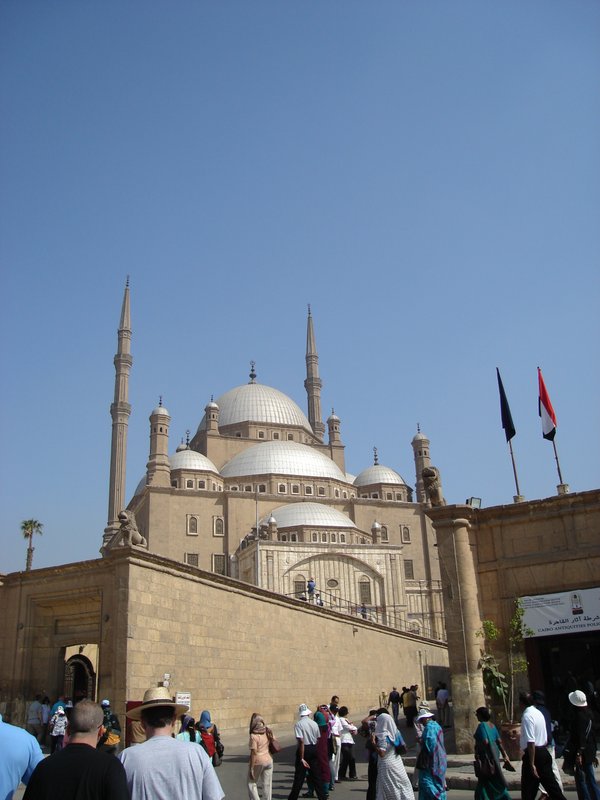

The Mosque of Muhammed Ali.
Cairo is a very big city, with endless quickly built, non-descript, unpainted brick buildings. In the residential slums, rubbish is a huge problem. People just put it into plastic shopping bags and throw it on the roof. I suppose it pays to live in the upper floors of a tall building, but we couldn’t believe that the roofs of many low rise buildings looked like a garbage dump.
Our second stop of the day was a visit to the Egyptian Museum. It is so massive that it can be completely overwhelming, but Ahmed focused us on a few areas of particular interest. After spending quite a bit of time viewing the treasures of Tut Ankh Amun (King Tut), we visited the hall of mummies and then had a wander around the ground level to view some of the larger pieces of the eclectic collection.
Later in the day we had a wander around the Souk of Khan El Khalili bazaar. While the narrow alleys and passages were very interesting architecturally, the shops were mostly full of tourist souvenir type items, and the after awhile the endless touting can be a bit much. We abandoned the shopping early and enjoyed a Turkish coffee and sheesha in one of the small cafes in the narrow passageways.
The Souk.
After a cocktail in the hotel lounge we enjoyed an Egyptian style dinner in the grand dining room of the hotel. After dinner, there was a show of Nubian dancing. The costumes were quite ornate and beautiful and the dancing very unique. After, we had a sheesha out in the garden with a view of the lighted pyramids off in the distance.
If one is keen to visit as many of the Thousand Places to See Before You Die, Egypt is a pretty good place to check out. I think we managed to catch about nine in just one week.
19 May
After a lovely room service breakfast, we hopped into a minivan for the trip back to Abu Tig Marina. On the outskirts of Cairo we made a very important stop-Carrefour! Carrefour is a chain of very nice grocery and general merchandise stores which we were first exposed to in Singapore. We spent three hours overloading a shopping cart with all the goodies that we had been deprived of or run out of since we last did a big provisioning in Southeast Asia.
Arriving back home in the early evening we found Moonshadow looking like she had been parked downwind of a volcanic eruption. In some places the dust was piled up nearly an inch thick!
20 May
We spent the morning washing off the huge accumulation of dust and sand, but with more fresh northerlies forecast, we knew it wouldn’t last long. We couldn’t wait to get out of Egypt, the desert, and the endless dust and sand.
23 May
After spending most of the morning cleaning the Arabian Desert off the inside/outside of Moonshadow, we departed Abu Tig Marina and headed northeast to Shab Umm Usk. We were told that there was a pod of very friendly dolphins there that we might be able to swim with. It was great to be on the move again, in clean air and water and away from the dust and noise of the marina. We didn’t spot any dolphins but enjoyed a quiet night on anchor out in the Red Sea reefs.
24 May
We got under way at about 0630 and retraced our track through the reef pass and headed north through the Straits of Gobul into the Gulf of Suez. We crossed the north/south shipping lanes in favor of the east side of the gulf. We were told that winds and seas are generally lighter on the east side, and it would put us on a more direct course towards Port Suez, well clear of the shipping lanes. With very light breezes forecast, we motored and didn’t even bother to pull off the mainsail cover.
The main hazards there were the myriad of oil wells and drilling rigs. In some areas there were more oil platforms per square mile than Starbucks outlets in a big city. Some of the rigs had long diagonal bits with flames burning at the extreme end, resembling giant genie lamps floating on the sea. Off to our starboard side was the Sinai Peninsula with its barren mountains poking out of the sandy desert. It was reminiscent of the awesome beauty of the scenery along the shore of the Sea of Cortez in Mexico.
A nice southeasterly breeze piped up in the mid-afternoon so we rolled out the genoa, shut down the engine and enjoyed sailing for the first time since we could remember, and made it to the anchorage at Shab el Hasa in time for sundowners.
We were contacted by our Suez Canal agent, Captain Heebi of the Prince of the Red Sea agency, who gave us an update on the weather. He told us that the wind would shift shortly from southeast to northwest. Sure enough, just after sundown, the wind died for a short while and then filled in at 15 knots from the northwest.
25 May
With a fresh northwesterly blowing, we had decided to stay put instead of bashing our way north. Captain Heebi called us at 1000 hours and told us that we should move north immediately or risk being weather bound where we were for 3-4 days, with even higher winds forecast. We got under way within minutes and started bashing through short 2 meter seas and winds up to 21 knots. It was not very comfortable, but we were prepared to put up with a bit of short term pain to avoid being stuck in the middle of nowhere for the rest of the week. After a few hours, the seas gradually began to moderate a bit, and by late in the afternoon we were moving nicely in slight seas and winds of less than 15 knots. We covered about 55 miles before sundown and found a comfortable anchorage off of a resort at Damaran Abu Mieish. This allowed us to escape the zone where the gales were forecast and by the time we settled in for a sundowner, the breeze was less than ten knots.
26 May
We woke up to calm winds, flat waters and a hazy horizon and were under way by 0630 hours, headed for Port Suez. Our course kept us clear of the main shipping channel funneling into and out of the Suez Canal, but through a couple of very large ship anchorages. The approach to Port Suez and the Suez Canal Yacht Club was very easy, and we hugged the right side of the channel to keep clear of the ships queuing up for the morning convoy.
28 May
Transit day!
As we departed Egypt and reflected a bit on our experiences there, we found it to be a friendly and fascinating place, and for the most part the people we came in contact with were warm, friendly and very welcoming. Having an opportunity to get up close and personal with so much incredible history, was truly an experience of a lifetime for us. The food and culture have made impressions that will last a lifetime.
The biggest irritation, more like a constant and annoying background noise, was the extreme tip/gift/baksheesh demand syndrome that has afflicted many of the lower paid people who interface with tourists. With the exceptions of the nice hotel, cruise ship and marinas where we stayed, it seems that nobody will give even the slightest courtesy without expecting or demanding a monetary reward. Policemen at the temples would smile and offer to take your photo, and then demand a tip. Attendants at the tombs would point out an interesting feature, and then stick out their hand. Bus and ferry boat drivers all announce that they wish to receive a gratuity. Most public restrooms have an “attendant” who collected 1 Egyptian Pound (about 18 U.S. cents) for the privilege of using a dirty toilet in a smelly restroom. In one case, when I insisted that the attendant clean an absolutely disgusting toilet before I would pay, he looked at me like I had two heads. Merchants would offer us small “free gifts” and then endlessly hound us to give them a gift (money of course) in return. We unfortunately had to refuse anything that was offered to us “free.” In some cases they were so irritatingly persistent about forcing us to take the “gift,” that we had to just lay it on ground and walk away. On the many occasions when we did pony up with some cash, almost invariably it was not enough, and we were shamelessly pressed for more. We got to the point where we would apologize and take it back, and they would finally realize that they had hit the limit. I think the expectation is that we should have emptied our pockets out and then led them to an ATM where we could get more. If you plan to visit Egypt, make sure you are prepared with a pocket full of small (1 pound and 50 piastres) notes before you go out anywhere in public.
Looking back on the Red Sea, most of the negative things we expected (gale force headwinds, sandstorms blasting off our paint, pirates, etc.), we never encountered, and the countless wonderful experiences we encountered, we never expected.

